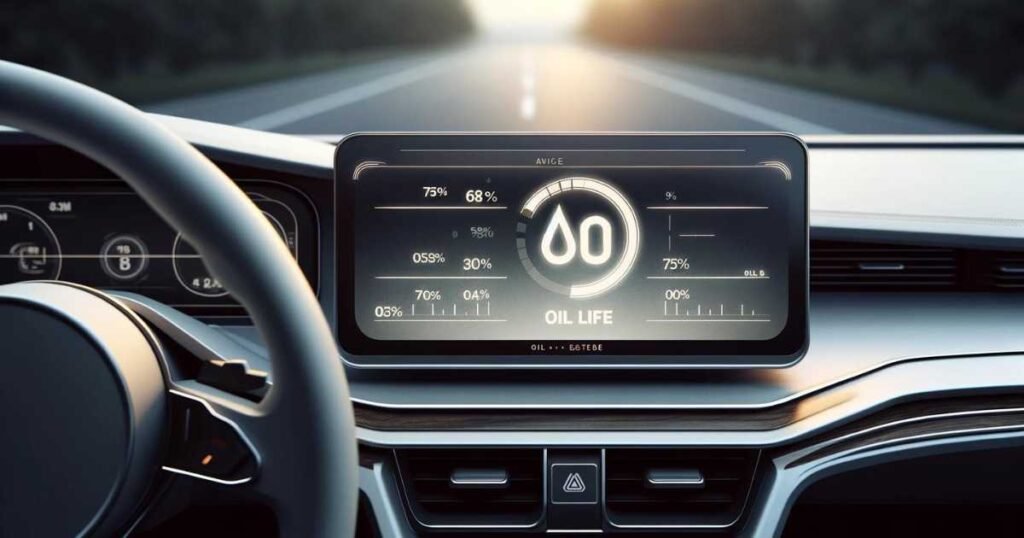Your car’s engine is like the heart of the vehicle, and the engine oil is like its blood. Just as blood is essential for our body, engine oil is very important for your car’s engine. It helps keep the engine’s parts moving smoothly without rubbing against each other too much. This is important because when parts rub together, it can cause damage.
But engine oil does not last forever. Over time, it gets old and doesn’t work as well. That’s why it’s important to change the engine oil regularly. Changing the engine oil is like giving your car fresh, healthy blood so it can keep running smoothly and last a long time.
This article will help you understand why changing your car’s engine oil is important and when you should do it. It’s like a guide to help you take good care of your car.
Table of Contents
What Percentage Should You Change Your Oil?
Here’s a general guideline based on the oil life indicator:
- 15% – 40%: Consider scheduling an oil change soon.
- Below 15%: Get your oil changed as quickly as possible.
These are just guidelines. Always consult your owner’s manual for the most accurate information for your specific vehicle.
There are two main ways to determine when an oil change is necessary:
1. Mileage: Traditionally, oil changes were recommended every 3,000 to 5,000 miles. However, advancements in oil technology and engine design have extended these intervals for many modern vehicles. Refer to your owner’s manual for the specific recommendation for your car, which can range anywhere from 5,000 to 12,000 miles or even longer.
2. Oil Life Indicator: Many modern cars have an oil life indicator on the dashboard. This system monitors various factors like engine RPM, oil temperature, and miles driven to estimate the remaining oil life percentage. It typically displays a number between 100% (fresh oil) and 0% (oil change needed).

Helpful: How Long Does Oil Last in a Car Not Driven?
What are Oil Life Percentage Readings?
When you see the oil life percentage in your car, it’s like a helpful guide telling you about the health of your car’s oil. But remember, it’s just an estimate. If your oil life shows 15%, it doesn’t mean the oil is no good anymore. You can drive safely for about 750 to 1,125 miles.
This is based on the distance people drive between oil changes, about 5,000 to 7,500 miles. Even so, getting your oil changed on time is really important. You don’t want to go past when your car’s manual says it is okay for the oil life.
How Oil Life Monitors Work in Modern Cars?
Modern cars are brilliant, especially when taking care of their oil. They have a unique system called an oil life monitor. This isn’t just a simple tool that looks at how many miles the car has driven. It’s much cleverer! It thinks about many things that can affect how long the oil in your vehicle stays good. Let’s see what these are:
First, the system thinks about how fast the engine runs, which is measured in Engine RPM. When the engine runs faster, the oil works harder and can break down quickly. Then, it considers how long the car has been driving. Driving a lot in busy city traffic or going on short trips can make the oil wear out faster than if you were cruising smoothly on the highway.
Another thing the system checks is how often you start your car when the engine is cold. Cold starts are when you first turn on your car after sitting for a while. When the engine is cold, the oil moves slowly and doesn’t protect the engine at first, which can be a bit tough on the oil.
Lastly, the oil life monitor looks at the engine’s temperature. Just like a hot summer day can tire you, extreme temperatures can make it hard for the oil to do its job right.
By looking at all these things – how fast the engine runs, how long you drive, cold starts, and the engine temperature – the oil life monitor can tell you a good guess about how long your car’s oil will last. This helps you know when to change the oil so your car stays healthy and runs smoothly. This way, the oil life monitor ensures your car’s oil is suitable for your driving style.
Should You Change Your Oil at 60% Oil Life?
When your oil life is at 60%, your oil can be used a bit longer. However, it’s really important to think about a few other things before you decide to wait longer to change your oil:
- What does the car maker say? For example, if you have a Honda Accord, you should look at the owner’s manual that came with your car. This manual will tell you how often the manufacturer thinks you should change your oil.
- How do you usually drive? Your oil must be changed more often if you drive in tough conditions. These can include short trips that give your car little time to run, being stuck in traffic where your car stops and goes a lot, or pulling heavy things with your car.
- How old is your car, and what condition is it in? As cars get older, their engines don’t work as well as they used to. This can make the oil work harder than when the car was new. Changing the oil more often is a good idea if your car is getting older.

How Long Will 15% oil Last?
Unfortunately, there’s yet to be a definitive answer to how long 15% oil life will last in terms of miles or time. It depends on various factors like:
- Driving habits: Frequent stop-and-go traffic, short trips, and towing put more stress on the oil, requiring earlier changes.
- Oil type: Synthetic oils generally last longer than conventional oils.
- Environmental conditions: Extreme heat or cold can accelerate oil degradation.
Therefore, it’s crucial to pay attention to your driving habits and environmental conditions and adjust your oil change schedule accordingly. If you need more clarification, consulting a qualified mechanic is always recommended.
Why do Timely Oil Changes Matter?
Skipping oil changes or waiting too long to change your oil isn’t suitable for your car. Here’s why changing your oil when you should be really important:
- Less wear and tear on your engine: New oil keeps everything in your engine moving smoothly. This means there’s less rubbing between parts, and they last longer.
- Better fuel efficiency: When your oil is clean, your engine runs more smoothly. This can help your car use less gas.
- Prevents damage to your engine: If you don’t change your oil when you should, it can get dirty and turn into sludge. This sludge can block the oil from moving around in your engine, leading to significant problems and even damaging your engine badly.
What is the Role of Engine Oil?
Engine oil is very important for your car’s engine. It has several crucial jobs to do:
- Friction Reduction: The oil creates a thin layer between the engine parts. This helps to reduce friction and wear when the engine is running.
- Heat Transfer: The oil absorbs heat from the engine parts. It then moves this heat to the radiator, which cools it down. This is important to stop the engine from getting too hot.
- Corrosion Protection: The oil has special additives. These additives protect the engine parts from rust. Rust can happen because of high temperatures, the constant rubbing of parts, and byproducts from burning fuel.
- Contamination Removal: As the engine works, it can make dirt, debris, and other harmful things. The oil helps by catching these contaminants. This keeps them from damaging the inside of the engine.
What are the Factors Affecting Oil Change Intervals?
Several things decide how often you should change your engine oil:
- Manufacturer Recommendations: Your car’s owner’s manual will tell you how often to change the oil. This advice is specific to your car model and engine. It considers how the engine is made, how much oil it holds, and the usual driving conditions.
- Oil Type: There are different kinds of oil. Synthetic oil usually works better and lasts longer than regular oil. Because of this, you might not need to change synthetic oil as often as regular oil. But always check what the manufacturer recommends.
- Driving Conditions: How you drive affects how often you need to change the oil. If you often drive in stop-and-go traffic, make short trips, or tow heavy loads, your engine oil works harder. This means you’ll need to change it more often. But if you primarily drive on highways at steady speeds, your oil gets more relaxed, so you can wait longer between changes.
- Oil Monitoring Systems: Many newer cars have systems that keep an eye on the oil. These systems look at the engine’s temperature, how many miles you’ve driven, and how good the oil is. They tell you when it’s time to change the oil.
Can You Rely on Oil Life Indicators?
Oil life indicators are valuable tools in your car, but it’s important to remember they could be better. These indicators work using special computer programs, but sometimes, they might need to get everything right. This is because they sometimes consider the unique ways you use your car. For example, if you drive in very hot or cold weather, pull heavy loads, or drive on rough, off-road paths, your car’s oil might get used up faster than the indicator says.
Also, like any other part of your car, the sensor that checks the oil life can stop working properly. If this happens, it might give you the wrong information about your oil. That’s why relying on something other than what the oil life indicator tells you is a good idea.
A smart move is to use the oil life indicator as a guide but also use your own judgment. It’s like having an extra helper when making decisions about your car. Plus, always check your car’s owner’s manual. It has specific advice on when to change your oil, tailored to your car model. This way, you can make sure your car stays healthy and runs smoothly.
See also: How Long After Oil Change Does the Light Come On?
What occurs when an engine’s oil life falls below 0%?
Modern oil life indicators typically don’t display a negative percentage. However, if you continue to drive well past the recommended oil change interval, the oil will eventually lose its lubricating properties when it reaches 0%. This can lead to:
- Severe engine damage: Metal components grinding against each other without proper lubrication can cause significant wear and tear, potentially leading to engine seizure.
- Increased emissions: Worn-out oil can increase emissions, harming the environment.
It’s crucial to avoid letting your oil life reach critically low levels to prevent these severe consequences.
Bottom Line
Regular oil changes are essential for maintaining your car’s engine health and performance. While oil life indicators offer a convenient way to monitor oil life, it’s crucial to consult your owner’s manual for the recommended service intervals and consider your driving habits. Following these guidelines and taking proactive maintenance steps ensures your car runs smoothly and efficiently for years.
Relevant:
What Does A Full-Service Oil Change Consists Of?
Does the Check Engine Light Come On For an Oil Change?
How Much Oil Do I Need for An Oil Change?
Are Oil Changes Covered Under Warranty?
How To Change Oil Pressure Sensor?
FAQs
What are the risks of operating a vehicle with depleted oil life?
Driving with low oil life is terrible for your car. Old oil can cause engine damage because of it:
- Increases friction: Old oil can’t protect engine parts from rubbing against each other, leading to damage.
- Causes overheating: Dirty oil doesn’t cool the engine properly, which can overheat and harm the engine.
- Creates sludge: Old oil turns into sludge, blocking oil flow and reducing engine performance.
Not changing your car’s oil on time can lead to expensive repairs, so it’s essential to do it regularly to keep your engine healthy and save money in the long run.
Should I change my oil to 25% oil life?
No, changing your oil at 25% is not typically recommended. While some sources suggest a range between 15% and 40% for scheduling an oil change, it’s crucial to consider your specific vehicle and driving habits.
Here’s a more nuanced approach:
- Consult your owner’s manual: It provides the manufacturer’s recommended oil change intervals based on your car’s model and engine type. This is the most reliable source of information.
- Oil life indicator: If your car has one, it can be a helpful tool, but don’t rely solely on it. These systems might need to account for individual factors like frequent short trips, extreme weather, or towing, which can shorten oil life.
- Consider your driving habits: If you primarily engage in stop-and-go traffic, make short trips, or tow frequently, consider changing your oil sooner than the recommended interval, potentially around 25%.
Is 10% oil life okay?
It’s generally not advisable to wait until the oil life reaches 10%. While some modern vehicles with synthetic oil and ideal driving conditions might be okay with this, it’s playing it too close to the edge.
Here’s why waiting until 10% is risky:
- Potential for engine damage: Extremely worn-out oil loses its lubricating properties, increasing friction and wear on engine components.
- Reduced engine performance: Thick oil can hinder efficient operation, decreasing fuel economy and power.
- Increased emissions: Breakdown products in used oil can contribute to higher emissions.
At what percentage should you change your engine oil?
There’s no single “one size fits all” answer to this question. The ideal oil change percentage depends on the following:
- Manufacturer recommendations: Refer to your owner’s manual for the specific interval for your car.
- Use the oil life indicator as a general guideline, but consider adjusting based on your driving habits and conditions.
- Driving habits: If you engage in severe driving conditions, consider changing oil sooner (around 25-30%).
- Oil type: Synthetic oil generally lasts longer than conventional oil.
Should I change oil at 5 percent?
Waiting until 5% oil life is strongly discouraged. At this point, the oil is likely significantly degraded and offers minimal protection to your engine. Continuing to drive with such low oil life can lead to severe consequences like engine damage, breakdowns, and costly repairs.
What are the different types of oil available for cars?
There are various motor oil types, including conventional, synthetic, and high-mileage oils, each formulated for specific needs and driving conditions. Consulting your owner’s manual or a qualified mechanic is recommended to choose the right oil for your car.
What happens if I neglect oil changes?
Neglecting oil changes can lead to several problems, including:
- Increased engine wear and tear
- Reduced fuel efficiency
- Overheating
- Engine failure
How much does an oil change typically cost?
The cost of an oil change varies depending on factors like your car’s make and model, the type of oil used, and labor costs. It typically ranges from $30 to $100.
![What Percentage Should You Change Your Oil [Ultimate Guide]](https://autoroadpro.com/wp-content/uploads/2024/02/What-Percentage-Should-You-Change-Your-Oil-Ultimate-Guide-1024x538.jpg)

